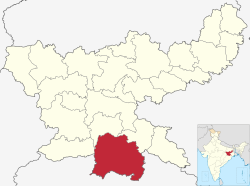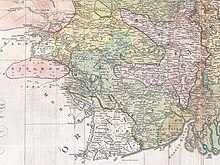West Singhbhum district
This article needs additional citations for verification. (April 2009) |
West Singhbhum district | |
|---|---|
 Location of West Singhbhum district in Jharkhand | |
| Country | |
| State | |
| Division | Kolhan |
| Headquarters | Chaibasa |
| Government | |
| • Deputy Commissioner | Shri Kuldeep Chaudhary (IAS) |
| • Lok Sabha constituencies | Singhbhum (shared with Seraikela Kharsawan district) |
| • Vidhan Sabha constituencies | 5 |
| Area | |
• Total | 7,224 km2 (2,789 sq mi) |
| Population (2011) | |
• Total | 1,502,338 |
| • Density | 210/km2 (540/sq mi) |
| Demographic | |
| • Literacy rate | 67.70 % |
| • Sex ratio | 958 |
| Language | |
| • Official | Hindi and English |
| • Regional | Ho, Mundari, Odia and Santali |
| Time zone | UTC+05:30 (IST) |
| Vehicle registration | JH-06 |
| Average annual precipitation | 1422 mm |
| Website | chaibasa |
West Singhbhum or Pashchimi Singhbhum is one of the 24 districts of Jharkhand state, India. It came into existence on 16 January 1990, when the old Singhbhum district (then in Bihar) was bifurcated. Chaibasa is the district headquarters.[1]
The district is bounded on north by Khunti district, on the east by Saraikela Kharsawan district of Jharkhand, on the southeast by Mayurbhanj district of Odisha, on the south by Kendujhar district of Odisha, and on the west by Simdega district of Jharkhand and Sundergarh district of Odisha.
History
[edit]Several Iron slags, microlith, Potsherds have been discovered from Singhbhum district which are from 1400 BCE according to Carbon dating age.[2]
Remains of a large city was excavated by Archaeological Survey of India in the village of Benisagar in West Singhbhum, suggesting continuous habitation in the region from 5th to the 16th-17th century.[3]

West Singhbhum is one of the oldest districts of Jharkhand. After the British conquest of Kolhan in 1837, a new district was consequently constituted to be known as Singhbhum with Chaibasa as its headquarters. Subsequently, three districts, namely East Singhbhum, West Singhbhum and Seraikela Kharsawan have been carved out of erstwhile Singhbhum district.[1]
West Singhbhum district came into existence when the old Singhbhum District bifurcated in 1990. With 9 community development blocks the Eastern part became East Singhbhum district with Jamshedpur as its headquarters and with remaining 23 blocks the larger Western part became West Singhbhum district with Chaibasa as its headquarters. In 2001 West Singhbhum again divided into two parts. With 8 blocks Saraikela-Kharsawan district came into existence. At present West Singhbhum remains with 18 blocks and three administrative sub-divisions.[1]
There are several accounts relating to the origin of the name of the district:
- According to one the name Singhbhum, or the land of "Singhs" has been derived from the patronymic of the Singh Rajas of Porahat, the junior branch of whom went on to found the ruling "Singh Deo" family of Saraikela State.[4]
- A second account suggests that the name is taken from the 'Singh Bonga' the principal deity of the district's tribal Bhumij-Munda population.[5]
It is currently a part of the Red Corridor.[6]
Geography
[edit]"The Singhbhum region is possibly Earth's earliest continental land exposed to the air...." Priyadarshi Chowdhury, a geologist at Australia's Monash University is an interesting recent discovery.
West Singhbhum district forms the Southern part of the newly created Jharkhand state and is the largest district in the state. The district spreads from 21.97°N to 23.60°N and from 85.00°E to 86.90°E. The district is situated at an average height of 244 metres above sea level and covers an area of 7629.679 km2.
The district is covered with hills alternating with valleys, steep mountains, and deep forests on the mountain slopes. It contains some of the best Sal tree forests and the famous Saranda forest. There are plenty of waterfalls and a large variety of wild life like elephants, bison, tigers, leopards, bear, wild dogs and wild boars. Sambar Deer and spotted deer are also found but their numbers are decreasing in the forests adjoining inhabited areas.
Rivers
[edit]Following are some of the rivers flowing in the West Singhbhum District: Koel, Karo-Koina, Kuju, Kharkai, Sanjai, Roro, Deo, and Baitarini.[7]
Flora and fauna
[edit]West Singhbhum district is full of dense forests and hills and harbors a variety of flora and fauna. Asia's largest Sal Forest Lies in This District
Mines and minerals
[edit]The greater part of West Singhbhum district is covered with deposits of iron-ore used for iron and steel industry. Other industrially important minerals including the following:
- Chromite
- Magnetite
- Manganese
- Kainite
- Limestone
- Iron Ore
- Asbestos
- Soap-stone
Administration
[edit]Blocks/Mandals
[edit]West Singhbhum district consists of 18 Blocks. The following are the list of the Blocks in West Singhbhum district:
Demographics
[edit]| Year | Pop. | ±% |
|---|---|---|
| 1901 | 356,991 | — |
| 1911 | 398,590 | +11.7% |
| 1921 | 421,587 | +5.8% |
| 1931 | 515,137 | +22.2% |
| 1941 | 614,298 | +19.2% |
| 1951 | 667,390 | +8.6% |
| 1961 | 765,128 | +14.6% |
| 1971 | 879,564 | +15.0% |
| 1981 | 922,491 | +4.9% |
| 1991 | 1,080,780 | +17.2% |
| 2001 | 1,233,945 | +14.2% |
| 2011 | 1,502,338 | +21.8% |
| Source: Census of India[8] | ||

According to the 2011 census West Singhbhum district has a population of 1,502,338,[9] roughly equal to the nation of Gabon[10] or the US state of Hawaii.[11] This gives it a ranking of 335th in India (out of a total of 640).[9] The district has a population density of 209 inhabitants per square kilometre (540/sq mi).[9] Its population growth rate over the decade 2001-2011 was 21.69%.[9] Pashchimi Singhbhum has a sex ratio of 1004 females for every 1000 males,[9] and a literacy rate of 58.63%. 14.51% of the population lives in urban areas. The Scheduled Castes and Scheduled Tribes collectively account for 71.1% (3.79% SC and 67.39% ST)[9] of the district's total population. The prominent communities in this group, in terms of the district's total population, are Ho (51.52%), Munda (9.33%), Oraon (2.15%), Bhuiya (1.36%), Santal (1.01%), Gond (0.91%), Ghasi (0.8%), Bhumij (0.71%), Pan (0.51%), Mahli (0.29%), Dhobi (0.25%), Dom (0.25%), Lohra (0.22%), Chamar/Muchi (0.19%), and Kora (0.13%). Additionally, other notable communities include Kharia, Chik Baraik, Bhogta, Turi, Birhor, Kol, Hari/Mehtar/Bhangi, Pasi, Savar, and Lalbegi have populations ranging between one thousand to a hundred.[12]
Religion
[edit]Language
[edit]At the time of the 2011 Census of India, 54.37% of the population in the district spoke Ho, 18.74% Odia, 9.16% Mundari, 4.64% Hindi, 2.53% Sadri, 2.08% Kurmali, 1.96% Urdu, 1.80% Bengali, 1.15% Kurukh and 1.03% Santali as their first language.[14]
Politics
[edit]| District | No. | Constituency | Name | Party | Alliance | Remarks | ||
|---|---|---|---|---|---|---|---|---|
| West Singhbhum | 52 | Chaibasa | Deepak Birua | Jharkhand Mukti Morcha | Mahagathbandhan (Jharkhand) | |||
| 53 | Majhgaon | Niral Purty | Jharkhand Mukti Morcha | Mahagathbandhan (Jharkhand) | ||||
| 54 | Jaganathpur | Sona Ram Sinku | Indian National Congress | Mahagathbandhan (Jharkhand) | ||||
| 55 | Manoharpur | Joba Majhi | Jharkhand Mukti Morcha | Mahagathbandhan (Jharkhand) | Won in 2024 Indian general election to Singhbum Lok Sabha Constituency | |||
| Vacant | ||||||||
| 56 | Chakradharpur | Sukhram Oraon | Jharkhand Mukti Morcha | Mahagathbandhan (Jharkhand) | ||||
References
[edit]- ^ a b c "About District | District West SinghBhum, Government of Jharkhand | India". Retrieved 2020-05-06.
- ^ Singh, Upinder (2008). A History of Ancient and Early Medieval India: From the Stone Age to the 12th Century. Pearson Education India. p. 220. ISBN 9788131711200.
- ^ "Archaeologists dig up 5th-century city at Jharkhand's Benisagar village". The Economic Times. 2023-07-30. ISSN 0013-0389. Retrieved 2023-08-05.
- ^ "NationStates | The Rajah of Singhbhum | Factbook". www.nationstates.net. Retrieved 2022-11-07.
- ^ "Saraikela Chhau Kendra | Art & Culture". jharkhandculture.com. Retrieved 2022-11-07.
- ^ "83 districts under the Security Related Expenditure Scheme". IntelliBriefs. 2009-12-11. Retrieved 2011-09-17.
- ^ "West Singhbhum district of Jharkhand". River Systempublisher = District administration. Retrieved 2010-04-20.
- ^ "Table A-02 Decadal Variation in Population Since 1901: Jharkhand" (PDF). census.gov.in. Registrar General and Census Commissioner of India.
- ^ a b c d e f "District Census Handbook: West Singhbum" (PDF). censusindia.gov.in. Registrar General and Census Commissioner of India. 2011.
- ^ US Directorate of Intelligence. "Country Comparison:Population". Archived from the original on June 13, 2007. Retrieved 2011-10-01.
Gabon 1,576,665
- ^ "2010 Resident Population Data". U. S. Census Bureau. Retrieved 2011-09-30.
Hawaii 1,360,301
- ^
- "A-10 Appendix: District wise scheduled caste population (Appendix), Jharkhand - 2011". Office of the Registrar General & Census Commissioner, India.
- "A-11 Appendix: District wise scheduled tribe population (Appendix), Jharkhand - 2011". Office of the Registrar General & Census Commissioner, India.
- ^ "Table C-01 Population By Religion: Jharkhand". census.gov.in. Registrar General and Census Commissioner of India.
- ^ a b "Table C-16 Population by Mother Tongue: Jharkhand". censusindia.gov.in. Registrar General and Census Commissioner of India.



